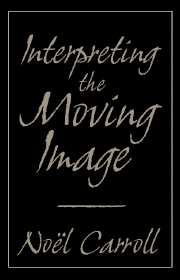Book contents
- Frontmatter
- Contents
- Foreword: Through Carroll's Looking Glass of Criticism
- Introduction
- 1 The Cabinet of Dr. Kracauer
- 2 Entr'acte, Paris and Dada
- 3 The Gold Rush
- 4 Keaton: Film Acting as Action
- 5 Buster Keaton, The General, and Visible Intelligibility
- 6 For God and Country
- 7 Lang, Pabst, and Sound
- 8 Notes on Dreyer's Vampyr
- 9 King Kong: Ape and Essence
- 10 Becky Sharp Takes Over
- 11 Interpreting Citizen Kane
- 12 The Moral Ecology of Melodrama: The Family Plot and Magnificent Obsession
- 13 Mind, Medium, and Metaphor in Harry Smith's Heaven and Earth Magic
- 14 Welles and Kafka
- 15 Nothing But a Man and The Cool World
- 16 Identity and Difference: From Ritual Symbolism to Condensation in Anger's Inauguration of the Pleasure Dome
- 17 Text of Light
- 18 Joan Jonas: Making the Image Visible
- 19 Introduction to Journeys from Berlin/1971
- 20 The Future of Allusion: Hollywood in the Seventies (and Beyond)
- 21 Back to Basics
- 22 Amy Taubin's Bag
- 23 Herzog, Presence, and Paradox
- 24 Film in the Age of Postmodernism
- Notes
- Index
20 - The Future of Allusion: Hollywood in the Seventies (and Beyond)
Published online by Cambridge University Press: 05 June 2012
- Frontmatter
- Contents
- Foreword: Through Carroll's Looking Glass of Criticism
- Introduction
- 1 The Cabinet of Dr. Kracauer
- 2 Entr'acte, Paris and Dada
- 3 The Gold Rush
- 4 Keaton: Film Acting as Action
- 5 Buster Keaton, The General, and Visible Intelligibility
- 6 For God and Country
- 7 Lang, Pabst, and Sound
- 8 Notes on Dreyer's Vampyr
- 9 King Kong: Ape and Essence
- 10 Becky Sharp Takes Over
- 11 Interpreting Citizen Kane
- 12 The Moral Ecology of Melodrama: The Family Plot and Magnificent Obsession
- 13 Mind, Medium, and Metaphor in Harry Smith's Heaven and Earth Magic
- 14 Welles and Kafka
- 15 Nothing But a Man and The Cool World
- 16 Identity and Difference: From Ritual Symbolism to Condensation in Anger's Inauguration of the Pleasure Dome
- 17 Text of Light
- 18 Joan Jonas: Making the Image Visible
- 19 Introduction to Journeys from Berlin/1971
- 20 The Future of Allusion: Hollywood in the Seventies (and Beyond)
- 21 Back to Basics
- 22 Amy Taubin's Bag
- 23 Herzog, Presence, and Paradox
- 24 Film in the Age of Postmodernism
- Notes
- Index
Summary
One rootless man, driven by an illicit passion for another man's wife; a murderous bargain with the siren; fateful destruction. It's an old story. Or, to be more exact, it's an old movie – shades of The Postman Always Rings Twice ('46) and Double Indemnity ('44). And yet, of course, it is also a new movie – Body Heat ('81), directed by Lawrence Kasdan, coauthor of such other historical pastiches as The Empire Strikes Back ('80) and Raiders of the Lost Ark('81). Nor does Body Heat merely rework an old plot. It tries to evoke the old films, films of the forties, that the plot was a part of. Body Heat's costumes are contemporary, but of a nostalgic variety that lets us – no, asks us – to see the film as a shifting figure, shifting between past and present. The lighting extensively apes the film noir style of the forties, thereby enhancing its mood of pessimism-cum-destiny by citing the approved cinematic iconography for fear, lust, and loathing. We understand Body Heat's plot complications because we know its sources – in fact, because, through its heavy-handed allusions, we've been told its sources.Without this knowledge, without these references, would Body Heat make much sense? Even its eroticism requires our explicit association of the female lead with certain movie myths – for example, the woman-as-devil/temptress archetype – in order to be really forceful.
Information
- Type
- Chapter
- Information
- Interpreting the Moving Image , pp. 240 - 264Publisher: Cambridge University PressPrint publication year: 1998
Accessibility standard: Unknown
Why this information is here
This section outlines the accessibility features of this content - including support for screen readers, full keyboard navigation and high-contrast display options. This may not be relevant for you.Accessibility Information
- 2
- Cited by
